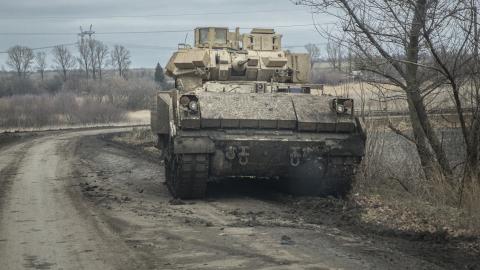Few could have imagined in the first few days after Russia’s large-scale invasion of Ukraine in February 2022 that the fighting would still be going on almost two years later.
After Ukraine’s success in liberating a sizeable chunk of territory by the end of 2022, little progress was made by either side in 2023: what little land that changed hands often did so at considerable cost to the attacker. Even with winter setting in, the level of fighting has not decreased much. Meanwhile both sides are preparing for 2024.
So what does the next year have in store for Ukraine and Russia? That is impossible to predict precisely. But based on what has happened over the past two years, some reasonable assumptions may be made. Here are four things to look out for.
First, expect support from some Western countries to slow down in the coming months. The best example of this is in the US. It has been more than a year since Congress last approved funding to arm Ukraine. With the politics playing out between the Republican-controlled House of Representatives and the Democrat-controlled Senate and White House, little progress is being made on additional funding. The top Republican contender for the presidency in November’s election, Donald Trump, has also stated his opposition to more aid for. There are enough Republican and Democrat members of Congress to approve additional aid, but the Republican leadership in the House of Representatives is blocking a vote — at least for now.
Meanwhile, some far-right governments in Europe, such those in Hungary and Slovakia, are threatening to use their powerful veto authority inside the EU to block future aid to Ukraine. Ultimately there will likely be plenty of Western support for Ukraine in 2024, but securing support for additional aid will not be as easy as it was during the early months of the war, and the pace of the aid will be slower.
Second, Russia will use 2024 to place itself on a more secure war footing. Despite heavy losses in manpower and equipment, Moscow is showing no indication that it wants to throw in the towel. In 2024 expect Russia to continue increasing the size of its armed forces. President Vladimir Putin will also devote record amounts to defense spending this year. The Russians have proved effective at circumventing Western economic sanctions and will continue to do so in 2024. This, combined with additional funding from the Kremlin, has allowed the Russian defense industry to survive and in some cases even grow.
The high levels of Russian casualties in Ukraine — some estimates suggest more than 300,000 killed and wounded— have not seemed to influence public opinion of the war. Most important, the Kremlin sees growing debate in the US about additional aid to Ukraine as a sign that the West is losing interest. All of this further emboldens the Kremlin.
Third, expect Iran and North Korea to continue, and in some cases increase, military aid to Russia. While many of Kyiv’s Western friends dither on supplying more weapons, Russia is not having the same problems with its partners. According to South Korean intelligence, North Korea has provided more than a million rounds of artillery shells to Russia and fragments of long-range North Korean ballistic missiles fired by Russia have been found in Ukraine. Iranian-produced drones have already been introduced to the conflict and are used almost weekly. As Russia continues to burn through its missile stockpiles, 2024 could be the year that Iranian ballistic missiles, such as the Fateh-110, are introduced into the conflict.
Finally, there is a wild-card scenario for 2024 in which the Ukrainians change the dynamics of the war in their favor. After almost a year of preparation and training, F-16 fighter jets will finally enter service for Ukraine before the summer. This could have a big impact on the battlefield, but Ukraine will need more to turn the tide. If the US and German governments finally provide the long-range missiles Ukraine needs to hit Russian targets and logistics sites deep in Crimea, Kyiv could gain the upper hand. These weapons are the American-made MGM-140 Army Tactical Missile System, known as ATACMS, and German-made Taurus air-launched cruise missiles.
The ATACMS are ballistic missiles with a range of 300 kilometers, meaning Ukraine could hit Russian targets in Crimea. Each missile can deliver a payload of up to 560 kg of explosives, depending on what type of warhead is used. The Taurus is a powerful missile with a range of 500 kilometers. Last year the Ukrainians were given a similar air-launched cruise missile called Storm Shadow/SCALP by the British and the French. These have been used effectively against the Russian Black Sea fleet. More Storm Shadow/SCALP missiles, combined with ATACMS, Taurus, and F-16s, could have a meaningful impact in the war in 2024.
Neither Kyiv nor Moscow has shown any willingness or desire to negotiate. Both sides believe that with the right strategy in place and with enough assistance from their friends they can be victorious. Both sides continue to pursue maximalist goals. The Kremlin is still committed to regime change in Kyiv and the demilitarization of Ukraine. Ukrainian President Volodomyr Zelensky has made it clear that he intends to liberate all of Ukraine’s internationally recognized territory under Russian occupation.
Nobody should expect 2024 to be a year of peace between Russia and Ukraine.


















